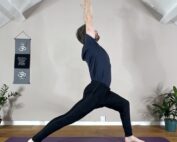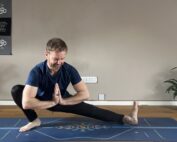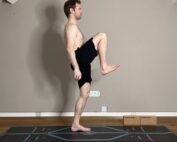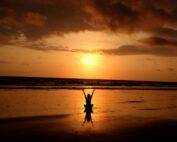
How to Practice Skandasana (Side Lunge Pose) with Strength, Mobility, and Awareness
By Dav Jones, Senior Yoga Teacher and Teacher Trainer
Skandasana, also known as Side Lunge Pose, is a posture that brings together the elegance of mobility and the strength of stability. On the outside, it looks like a deep squat to one side – but within, it’s a powerful training ground for leg strength, joint health, breath-spine coordination, and proprioceptive awareness.
This guide explores Skandasana through both the yogic lens of balance and the kinesiologist’s lens of muscular engagement, joint alignment, and movement mechanics. You’ll learn how to practice it safely, modify it for your structure, and experience its wide-ranging benefits.
What Is Skandasana?
Skandasana is a lateral lunge-like posture often practiced in hip-opening sequences. Unlike static forward bends, this pose emphasizes transitions, shifting body weight across the frontal plane.
Sanskrit roots:
- Skanda – warrior, strength, or the Hindu god of war
- Asana – posture
Functionally, Skandasana is more than a stretch – it’s a closed-chain movement that mobilizes the hips, strengthens the legs, and integrates the breath with spinal stability. It mimics primal movement patterns (deep squat, lateral shifting) that are essential for daily function and athletic performance.
Benefits of Skandasana (Side Lunge Pose)
Physical Benefits (Kinesiological Insights)
- Deep Hip Opening: Lengthens the adductors (inner thighs), mobilizes the hip capsule, and stretches the hamstrings of the extended leg.
- Strengthens Lower Body: Engages quadriceps, hamstrings, and gluteus maximus on the bent leg side, while stabilizing through gluteus medius and adductors.
- Joint Health: Encourages movement across multiple planes—hip flexion, abduction, and external rotation supporting hip and knee resilience.
- Ankle Mobility: The dorsiflexion of the bent leg’s ankle strengthens stabilising muscles and supports balance.
- Fascial Engagement: Activates the deep front line and spiral line of the fascia, supporting fluid movement and balance.
Mental & Energetic Benefits
- Grounding Presence: Rooting into the bent leg encourages stability and inner calm.
- Focused Awareness: Demands concentration to balance shifting weight.
- Adaptability: The side-to-side motion mirrors the need for fluid adaptability in both body and life.
- Energetic Flow: Balances Muladhara (root chakra) for grounding and Svadhisthana (sacral chakra) for creativity and fluidity.
Step-by-Step Guide to Performing Skandasana

1. Set the Foundation
- Begin in Prasarita Padottanasana (Wide-Leg Forward Fold).
- Feet about 3 – 4 feet apart, parallel and rooted.
Kinesiologist’s note: Keep the arches and tripod of the foot rooted to encourage the engagement of the foot stabilisers.
2. Shift into the Lunge
- Bend the right knee, lowering hips toward the heel.
- Extend the left leg, toes pointing upward.
Kinesiologist’s note: This combines hip flexion, external rotation and abduction in the bent leg with hamstring lengthening in the extended leg. Control the descent by eccentrically lengthening quadriceps and glutes in the bent leg.
3. Ground Through the Heel
- Anchor the heel of the bent leg.
- Actively press through the extended heel to maintain length.
Kinesiologist’s note: Heel grounding recruits the posterior chain (hamstrings, calves, glutes) for stability.
4. Spine and Core Integrity
- Keep the torso tall and spine elongated.
- Engage the core to prevent collapsing forward.
Kinesiologist’s note: Think of the spine as a “bridge” supported by hip hinging, not a hinge point itself. Maintain intra-abdominal pressure with steady breath.
5. Hands for Balance
- Place hands on the floor for support, or bring palms to the heart center in Anjali Mudra.
Kinesiologist’s note: Hands on the ground create closed-chain feedback to help train proprioception.
6. Breathe into the Pose
- Stay for 5 – 8 breaths, keeping both legs active.
- With each exhale, soften tension without collapsing alignment.
7. Transition Fluidly
- Press through the bent leg to rise back up.
- Shift across to the other side, maintaining control through the core.
Modifications and Props
- Limited Hip Mobility? Stay higher in the lunge or sit on a block.
- Tight Hamstrings? Keep the extended leg’s foot grounded instead of lifting the toes.
- Balance Challenges? Practice with support from a wall.
Variations of Skandasana
- Prayer Hands (Anjali Mudra): Trains balance and proprioception.
- Arms Forward: Increases core recruitment while lengthening the spine.
- Flowing Skandasana: Shift side-to-side with the breath, training eccentric strength and dynamic flexibility.
- Twisted Skandasana: Add a gentle rotation through the thoracic spine.
- Chair-Assisted Skandasana: Sit on a chair, extending one leg outward for an accessible variation.
Key Principles of Practicing Skandasana
- Alignment Before Depth: Prioritise knee tracking (over second toe) and upright spine before dropping lower.
- Breath-Spine Integration: Use the diaphragm to support spinal length and pelvic stability.
- Active Engagement: Both legs are alive – bent leg stabilises, extended leg lengthens.
- Strength Meets Mobility: Think of Skandasana not just as a stretch but as a functional mobility strength exercise.
When to Use Skandasana in Practice
- After Standing Poses: Complements Warrior II and Triangle Pose with hip release.
- Before Seated Poses: Prepares hips for forward folds and splits.
- As Functional Training: Mimics athletic lateral movement patterns.
- In Grounding Sequences: Encourages stillness after dynamic flows.
Contraindications and Cautions
- Knee Injuries: Avoid deep lunges; use higher stance or props.
- Hip Impingement: Work within pain-free range.
- Ankle Instability: Strengthen progressively with partial depth.
- Pregnancy: Avoid deep compression; practice supported or chair variation.









